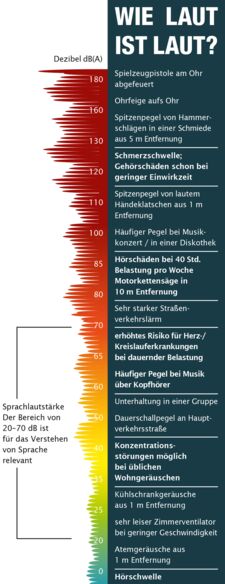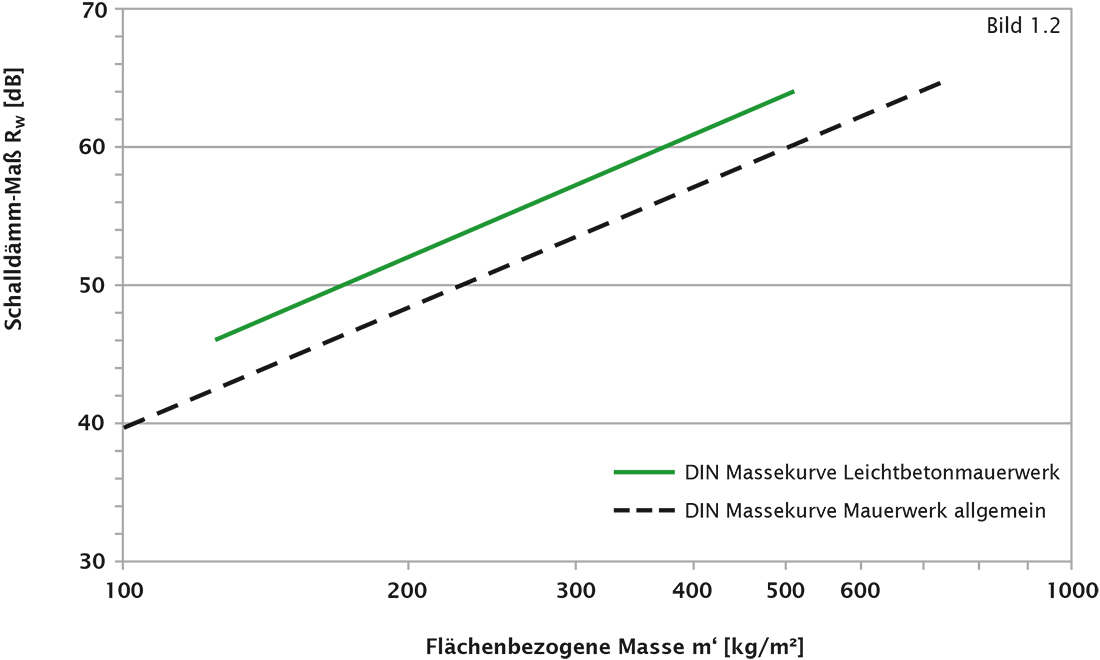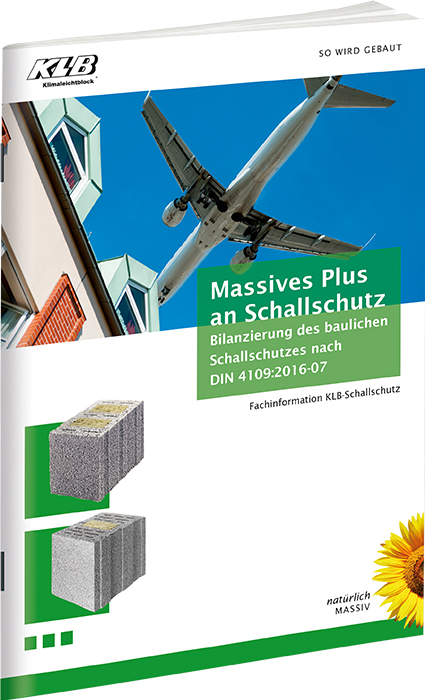Masonry and sound insulation
Solid sound insulation with KLB system walls
The building sound insulation is one of the most important individual protection goals in structural engineering. Contrary to the absolute objective requirements on the load limit of the masonry, the fire and thermal protection this is a subjectively perceptible quality, which can definitely be perceived differently by the user. The sound insulation of a component is therefore generally dimensioned beyond a minimum value in its performance capacity to the needs of the user.
In particular in multi-family houses with neighbouring apartments aligned directly next to each other horizontally and vertically sufficient or even increased noise protection is harder to achieve due to the construction than between vertically separated town houses and duplexes. In freestanding single family homes, on the other hand, this generally concerns noise protection from outside noise. Therefore standard or desired building noise protection depends on numerous factors.
First the desired protection goal should be determined during the planning phase. The noise protection requirements of DIN 4109, which were published last year and which may not be undercut, apply as a basis. In addition, higher standards can be agreed between the client and the developer - for example according to DIN 4109, Supplement 2.
In solid brickwork made of lightweight concrete blocks, the porous structure and the aggregates of the building material used make the masonry more resistant to the mass per unit area than the wall-building materials of the same weight, e.g. sand-lime brick. The mass curves specified in DIN 4109 take this circumstance into consideration.
The sound insulation of light-weight concrete masonry depending on the surface related mass can be seen clearly in the following diagram for KLB masonry systems.
KLB Noise Protection Approval
Highly heat insulating exterior wall products are regulated in their own KLB approval due to their different inner geometry. This approval also permits the use of highly thermally insulating exterior wall materials with peak thermal conductivity values for structural sound insulation - or to provide proof of sound insulation.
Even for highly thermally insulating KLB functional walls, sound insulation - for example against external noise or also against foreign living and working areas (double-skinned house partitions, multi-family houses) - can thus be carried out in a simple and safe manner. A current KLB brochure provides comprehensive information on the subject of noise protection. In particular, proposals for increased sound insulation in apartment buildings - as well as construction solutions - will be presented in a practical manner.
Detailed information is available in our brochure “Solid Plus in Sound Insulation”.
The KLB Noise Protection Guide
How loud is loud?

The building sound insulation is one of the most important individual protection goals in structural engineering. In contrast to thermal insulation, sound insulation does not affect the residents of a house in euros or cents, but its importance is no less important. This is because the well-being and health of humans depends significantly on sufficient noise protection. Noise protection therefore means reducing or eliminating as far as possible any type of noise that is generated in its impact on people.
Contrary to the absolute objective requirements on the load limit of the masonry, and the fire and thermal protection these are subjectively perceptible qualities, which can definitely be perceived differently by the user. The noise insulation of a component therefore is dimensioned beyond a minimum value in its performance capacity to the needs of the user.
It is for example known that in multi-family houses with neighbouring apartments aligned directly next to each other horizontally and vertically less noise protection can be achieved due to the construction than between vertically separated town houses and duplexes. In freestanding single family homes neighbourhood noises do not matter. In the worst case it concerns protection against outside noise.
General Information
Subjective perception of noise protection
The perceptible noise protection is determined mainly by the always present background noises within an apartment as well as also the apartment surroundings from outside.
If no noise or only little noise penetrates from outside, there is a very low background noise level in living spaces without activities, which can increase the perceptibility of disturbing noises from neighbouring apartments.
Table: Subjective effect of sound insulation measures related to the noise source "normal-loud speech" according to Gösele as a function of the basic noise level in the room and the sound insulation of the separating component.

A clearly perceptible improvement in noise protection occurs for quiet noises starting at 3 dB, for very loud noises at about 10 dB of increased noise insulation. For this reason the determination of the noise protection qualities of the components in particular in multi-family apartment construction in the ideal case should be cleared with the user in advance. It has to be noted here that absolute silence within an apartment cannot be reached since the noise development of the different sound sources cannot always be influenced. The scale on page 3 shows the daily noise level of different sources and thereby allows a comparative estimate of the disruptive impact and the desired protective goal.
PRACTICE TIP: The noise protection in apartment construction is only a very small part of the scale: about 45 dB(A) are typical living noises. At 25 dB(A), the breathing of a person one meter away probably represents the lowest sound emission occurring in practice.
A standard or desired building noise protection depends on numerous factors. First the desired protection goal should be determined during the planning phase. The basis for this is the noise protection requirements of DIN 4109 under building regulations, which must not be undercut. In addition, higher standards, such as DIN SPEC 91314:2017-01, can be set between the client and the developer .
PRACTICE TIP: Today's quality and comfort standards may require increased efforts in noise control. The jurisdiction of the Federal Court of Justice (BGH) has demanded that sound insulation in upmarket residential buildings be designed in such a way that it meets the expectations of the building user and, above all, the efficiency of the construction carried out. Therefore it makes sense to represent the desired noise protection level transparently and to agree to it contractually.
In solid construction, the sound insulation of masonry made of lightweight concrete blocks is always higher than that of equally heavy wall construction materials due to its porous structure and the aggregates of the building material used as a function of the mass per unit area. The mass curves specified in DIN 4109 take this circumstance into consideration.

Diagram: Noise insulation of light-weight concrete blocks depending on the surface related mass. In the area of m 140 – 480 kg/m² the noise insulation measure Rw is about 2 dB higher than of masonry in general.

PRACTICE TIP: Advantage of + 2 dB when implementing with light-weight concrete building materials with identical wall thickness and gross density class (RDK) in comparison to masonry in general!


